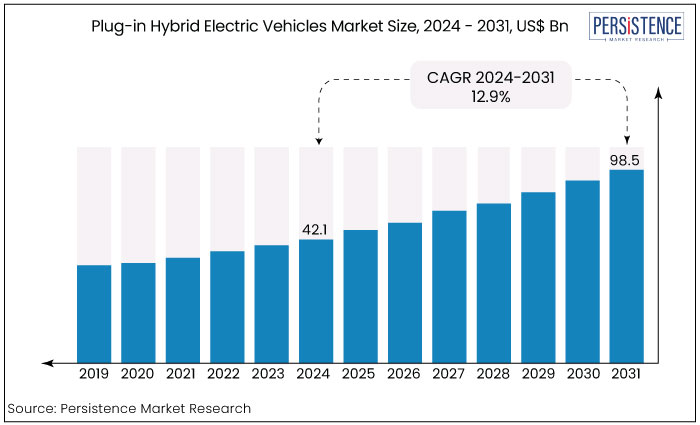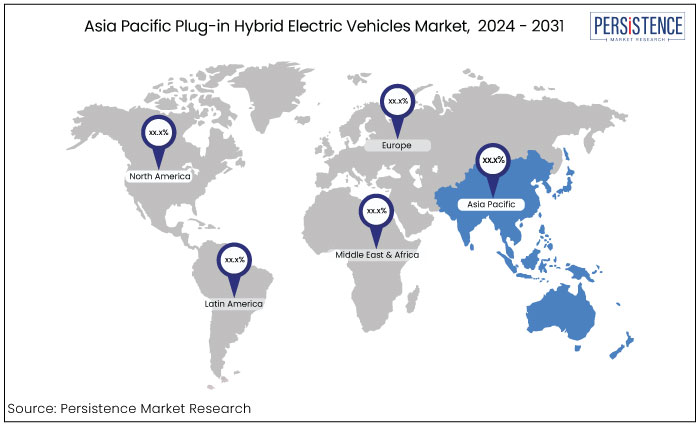Plug-in Hybrid Electric Vehicles Market
Industry: Automotive & Transportation
Published Date: September-2024
Format: PPT*, PDF, EXCEL
Delivery Timelines: Contact Sales
Number of Pages: 181
Report ID: PMRREP18595
The plug-in hybrid electric vehicles market is estimated to increase from US$42.1 Bn in 2024 to US$98.5 Bn by 2031. The market is projected to record a CAGR of 12.9% during the forecast period from 2024 to 2031.

Key Highlights of the Market
|
Market Attributes |
Key Insights |
|
Market Size (2024E) |
US$42.1 Bn |
|
Projected Market Value (2031F) |
US$98.5 Bn |
|
Global Market Growth Rate (CAGR 2024 to 2031) |
12.9% |
|
Historical Market Growth Rate (CAGR 2019 to 2023) |
8.1% |
Asia Pacific is poised to emerge as the dominant regional market. This region’s substantial population, predominantly composed of middle-class consumers has positioned it as the largest market for PHEVs. As demand for environmentally friendly transportation options continues to grow, sales volumes in this area are expected to rise steadily.
Escalating gasoline prices are prompting many consumers to consider PHEVs as a cost-effective alternative, further driving their popularity. The combination of increasing urbanization and economic growth in the region supports a favorable outlook for PHEV sales in the coming years.

North America is projected to experience the high growth rate in the plug-in hybrid electric vehicles market during the forecast period. This surge can be attributed to strategic partnerships among automakers, government agencies, and environmental organizations focused on promoting awareness of hybrid electric vehicles.
By launching educational campaigns and incentives, these collaborations aim to enhance consumer understanding of the benefits of PHEVs, thereby stimulating demand. As interest in sustainable transportation solutions continues to rise, North America is poised to play a pivotal role in shaping the future of the global PHEV market.
The parallel hybrid segment is expected to dominate the plug-in hybrid electric vehicles market during the forecast period. This innovative configuration connects both the internal combustion engine and the electric motor directly to the wheels allowing the vehicle to operate in parallel hybrid mode.
The engine primarily drives the wheels, while the electric motor provides assistance when needed. This operational design offers numerous advantages, such as eliminating efficiency losses that typically occur during power conversion between electric components and the battery. Additionally, it allows for a small traction motor and removes the necessity for a generator, enhancing overall efficiency.
The stored electricity segment is predicted to lead the plug-in hybrid electric vehicles market. This segment relies on the low-voltage auxiliary battery, which plays a crucial role in powering the vehicle. It provides the initial electricity needed to start the vehicle before the traction battery is activated. Additionally, this auxiliary battery is responsible for powering various accessories within the PHEV, ensuring a seamless user experience.
As advancements in battery technology continue to evolve, the importance of stored electricity in enhancing vehicle performance and efficiency will likely remain a key focus for manufacturers and consumers alike.
The market overview shows that the sector has grown remarkably, and it has great potential for growth in upcoming years.
Plug-in hybrid electric vehicles (PHEVs) are a type of electric vehicle that combines a traditional internal combustion engine (ICE) with an electric propulsion system. This dual-fuel system enhances fuel efficiency and reduces greenhouse gas emissions, making PHEVs an appealing choice for environmentally conscious consumers.
The sector is witnessing significant trends driven by shifts in consumer preferences, technological advancements, and regulatory frameworks. The global push for sustainability and stringent emissions regulations are propelling the demand for PHEVs, as they offer a transitional solution between conventional vehicles and fully electric alternatives.
Advancements in battery technology are enhancing the electric range of PHEVs, making them more appealing to a broader audience. Additionally, the growing availability of charging infrastructure is alleviating range anxiety, further encouraging adoption. Among other plug-in hybrid electric vehicles market trends, the shift toward smart and connected vehicles is one influencing trend in the PHEV market.
Manufacturers are also integrating advanced connectivity features that enhance the driving experience and enable more efficient energy management. As consumers increasingly prioritize eco-friendly options, the PHEV market is poised for robust growth with forecasts indicating an expanding share in the overall automotive landscape.
The plug-in hybrid electric vehicles market analysis has shown notable growth from 2019 to 2023 with a CAGR of 8.1% during this period. This growth can be attributed to increasing consumer awareness of environmental issues, advancements in hybrid technology, and supportive government policies aimed at reducing carbon emissions.
As more consumers seek sustainable transportation options, PHEVs have emerged as a practical solution offering the flexibility of both electric and gasoline power. Further, the market is projected to accelerate significantly with an anticipated CAGR of 12.9% from 2024 to 2031.
Expected market surge is driven by several factors including ongoing improvements in battery technology that enhance electric range and efficiency as well as the expansion of charging infrastructure. The automotive industry is increasingly focusing on electrification with many manufacturers committing to a broad range of PHEV models.
Environmental Awareness and Regulations
Growing environmental concerns and stringent government regulations are key drivers for the plug-in hybrid electric vehicles market growth. As climate change becomes a pressing global issue, consumers are increasingly seeking eco-friendly transportation options.
Governments worldwide are implementing policies that promote the adoption of low-emission vehicles, including tax incentives, rebates, and strict emissions standards. These initiatives encourage consumers to consider PHEVs and push manufacturers to innovate and expand their offerings making PHEVs a more attractive choice for environmentally conscious buyers.
Advancements in Battery Technology
Technological advancements in battery technology are a crucial growth driver for market expansion. Improvements in battery efficiency, capacity, and charging speed have significantly enhanced the performance and appeal of PHEVs.
As manufacturers develop lighter, more powerful batteries, the electric range of PHEVs continues to increase, allowing drivers to rely more on electric power for daily commutes. Additionally, fast charging solutions are reducing downtime making PHEVs more convenient for consumers. These innovations are essential in attracting a broad audience and fostering greater adoption of PHEVs.
Expanding Charging Infrastructure
The expansion of charging infrastructure is another vital factor propelling the growth of the plug-in hybrid electric vehicles market. As more charging stations become available in urban and rural areas, consumers are less likely to experience range anxiety, which has historically hindered the adoption of electric vehicles.
Increased accessibility to charging facilities encourages potential buyers to consider PHEVs as a viable option for their transportation needs. Furthermore, partnerships between governments and private companies to enhance charging networks are fostering a supportive environment for PHEV adoption, ultimately driving market growth.
High Initial Costs
One of the primary factors impeding the plug-in hybrid electric vehicles market growth is the high initial purchase price compared to conventional vehicles. Although PHEVs offer long-term savings on fuel and maintenance, the upfront costs can deter potential buyers, especially in price-sensitive markets.
Many consumers are hesitant to invest in PHEVs when cheaper alternatives are available, even if they are less environmentally friendly. This financial barrier can limit market penetration and slow the transition to more sustainable vehicle options, impacting overall adoption rates.
Limited Consumer Awareness
Limited consumer awareness and understanding of PHEVs also pose a hindrance to the growth of the market. Many potential buyers are still unfamiliar with the benefits and functionalities of PHEVs leading to misconceptions about their performance and efficiency. This lack of knowledge can result in a reluctance to consider PHEVs as a viable option compared to traditional vehicles or fully electric cars.
Effective marketing and educational initiatives are essential to inform consumers about the advantages of PHEVs including their environmental benefits and cost savings to drive great acceptance and adoption in the market.
Integration of Smart Technology
The integration of smart technology presents a significant opportunity for the plug-in hybrid electric vehicles market expansion. As vehicles become increasingly connected, the incorporation of advanced features such as real-time energy management, predictive maintenance, and mobile app connectivity can enhance the user experience.
By providing drivers with detailed information about their vehicle's performance, charging status, and energy usage, manufacturers can improve consumer confidence and satisfaction. Furthermore, integrating smart technology with renewable energy sources can optimize charging practices, making PHEVs even more appealing to environmentally conscious consumers.
Expansion into Emerging Markets
The expansion of PHEVs into emerging markets represents a promising opportunity for market. As urbanization increases and middle-class populations rise in countries such as India, Brazil, and Southeast Asia, there is a growing demand for affordable and efficient transportation solutions.
PHEVs can address this need by offering a balance between electric capability and traditional fuel options, making them suitable for regions with limited charging infrastructure. By tailoring marketing strategies and vehicle offerings to meet the specific needs of these markets, manufacturers can tap into a vast consumer base and drive significant adoption rates.
The market is characterized by robust competition among major automotive manufacturers. For instance, Toyota continues to lead with innovative products such as the 2023 RAV4 Prime, which features an enhanced electric range and advanced safety technologies.
Ford has launched the 2022 Escape Plug-In Hybrid, offering improved efficiency and connectivity features. These companies are focusing on enhancing performance, expanding electric ranges, and integrating smart technology to capture a larger share of the growing PHEV market, driving innovation and consumer interest.
Recent Developments in the Plug-in Hybrid Electric Vehicles Market
|
Attributes |
Details |
|
Forecast Period |
2024 to 2031 |
|
Historical Data Available for |
2019 to 2023 |
|
Market Analysis |
US$ Billion for Value |
|
Key Regions Covered |
|
|
Key Market Segments Covered |
|
|
Key Companies Profiled |
|
|
Report Coverage |
|
|
Customization & Pricing |
Available upon request |
By Power Source
By Powertrain
By Region
To know more about delivery timeline for this report Contact Sales

The market is predicted to rise from US$42.1 Bn in 2024 to US$98.5 Bn by 2031.
Some of the leading players operating in the market are Nissan Motor Co., Ltd, Mercedes-Benz Group AG, and General Motors.
The parallel hybrid based on powertrain category is leading segment.
Asia Pacific is a leading region due to its large population of middle-class consumers.
Improvements in battery efficiency, and more charging stations is a key trend in the market.